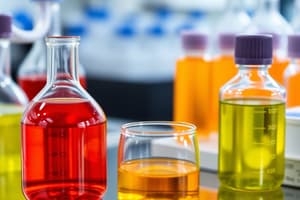Podcast
Questions and Answers
Classical methods include techniques such as precipitation, extraction, and ______.
Classical methods include techniques such as precipitation, extraction, and ______.
distillation
Volumetric methods measure the volume of a solution containing sufficient ______ to react completely with the analyte.
Volumetric methods measure the volume of a solution containing sufficient ______ to react completely with the analyte.
reagent
Spectroscopic methods are based on the measurement of the interaction between electromagnetic radiation and ______ atoms or molecules.
Spectroscopic methods are based on the measurement of the interaction between electromagnetic radiation and ______ atoms or molecules.
analyte
Electroanalytical methods involve the measurement of electrical properties such as voltage, current, and ______.
Electroanalytical methods involve the measurement of electrical properties such as voltage, current, and ______.
Gravimetric methods determine the ______ of the analyte or a chemically related compound.
Gravimetric methods determine the ______ of the analyte or a chemically related compound.
The ______ method involves measuring the mass of a sample to determine its chemical composition.
The ______ method involves measuring the mass of a sample to determine its chemical composition.
In ______ analysis, the sample mass typically ranges from 0.01 to 0.1 g.
In ______ analysis, the sample mass typically ranges from 0.01 to 0.1 g.
______ constituents are defined as those present in concentrations ranging from 0.01% to 1%.
______ constituents are defined as those present in concentrations ranging from 0.01% to 1%.
A ______ analysis determines the quantities of all the constituents in a sample.
A ______ analysis determines the quantities of all the constituents in a sample.
When performing a quantitative analysis, the first step is to select a ______.
When performing a quantitative analysis, the first step is to select a ______.
Flashcards are hidden until you start studying
Study Notes
Analytical Methods in Chemistry
- Two main types of analytical methods: classical and instrumental.
- Classical Methods: Involves wet chemistry techniques, such as:
- Precipitation
- Extraction
- Distillation
- Measurements of melting or boiling points
- Gravimetric and volumetric (titration) techniques, including:
- Acid-base titration
- Oxidation-reduction titration
- Precipitation titration
- Complexometric titration
- Instrumental Methods: Utilize equipment for analytical measurements, including:
- Conductivity
- Electrode potential
- Light absorption/emission
- Mass-to-charge ratio
- Fluorescence
Classes of Quantitative Analytical Methods
- Gravimetric Methods: Assess the mass of analyte or related compounds.
- Volumetric Methods: Measure the volume of a reactive solution.
- Spectroscopic Methods: Measure interactions between electromagnetic radiation and analyte.
- Chromatographic Methods: Use separation and quantitation via calibration curves.
- Electroanalytical Methods: Measure electrical properties like voltage, current, and resistance.
- Miscellaneous Methods: Include measurements of mass-to-charge ratio, radioactive decay, heat of reaction, reaction rates, thermal conductivity, optical activity, and refractive index.
Classification of Quantitative Methods
- Based on Sample Size:
- Macro Analysis: Samples > 0.1 g.
- Semimicro Analysis: Samples 0.01-0.1 g.
- Micro Analysis: Samples 0.0001-0.01 g.
- Based on Constituent Type:
- Major Constituent: 1%-100%.
- Minor Constituent: 0.01%-1%.
- Trace Constituent: 100 ppm - 1 ppb.
- Ultra Trace Constituent: < 1 ppb.
- Based on Number of Analyzed Constituents:
- Complete Analysis: Quantifies all constituents in a sample.
- Partial Analysis: Quantifies only some constituents.
- Single Component Analysis: Quantifies one substance only.
Steps in Quantitative Analysis
- Select a Method: Choose between classical or instrumental, considering relevant factors.
Introduction to Analytical Chemistry
- Involves qualitative and quantitative characterization of matter.
- Qualitative Analysis: Identifies chemical compounds or elements in a sample.
- Quantitative Analysis: Measures the exact amount of substances in a sample.
Studying That Suits You
Use AI to generate personalized quizzes and flashcards to suit your learning preferences.




